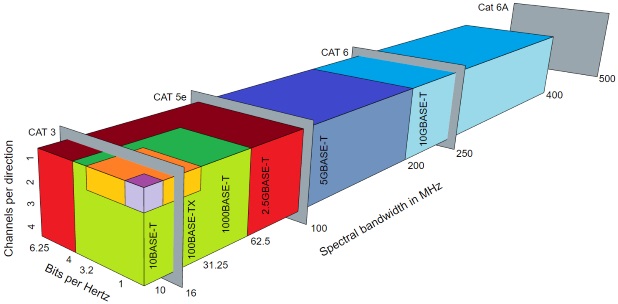Cat5e and Cat6 cables get a 5Gbps speed boost
 2017-06-01
2017-06-01
 HSDCable
HSDCable
 342
342
Gigabit Ethernet is ubiquitous. If you work in corporate IT, chances are you service at least one site wired with Category 5e or Category 6 cabling running 1000BASE-T. However, as networks expand and add new services, Gigabit Ethernet may start to feel a little congested. Adding or replacing cabling is an expensive proposition, but never fear: the IEEE has just ratified proposal 802.3bz-2016, which lays out the new 2.5GBASE-T and 5GBASE-T specifications. The new specs define a method for delivering 2.5Gbps and 5Gbps over existing Cat5e and Cat6 cables.

"But wait, TR," gerbils are already crying. "Cat6 cables support 10GbE!" Yes, over short distances, Category 6 cables can run 10GBASE-T. However, the new standard lets those cables support a 5Gbps data rate across 100-meter runs. 802.3bz equally allows for Category 5e cabling to offer 5Gbps performance "on defined use cases and deployment configurations." For other configurations, Cat5e cabling will be limited to 2.5Gbps, which is neverthless a 150% improvement over standard Gigabit Ethernet.
As far back as 2013, networking vendors looked ahead and saw the toll that high-end Wi-Fi gear would take on their networks. The "wave 2" expansion of 802.11ac has a maximum theoretical throughput of almost 7Gbps, and even first-generation 802.11ac can deliver faster-than-GbE speeds with high-end MIMO gear. Enterprise Wi-Fi installations servicing many users could already step over the gigabit boundary with ease.
To cope with this demand, those vendors formed two competing alliances working toward the goal of achieving higher-than-Gigabit speeds over existing wiring. Today's release of an IEEE standard regarding the technology should prevent any further interoperability concerns that might have been raised by the existence of these two separate groups.
Certain high-end gear—like some of Cisco's Catalyst Ethernet switches—already supports the intermediate speeds. However, most 10GBASE-T equipment will not be able to step down to 2.5GBASE-T or 5GBASE-T. Purchasing new networking equipment is both cheaper and easier than re-wiring structures, though.




